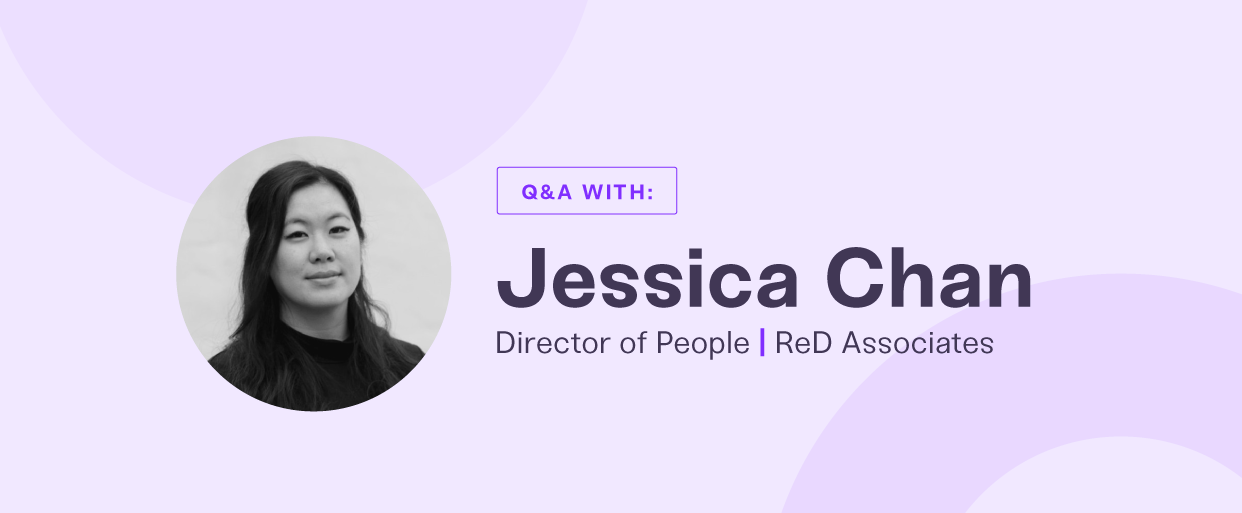
We all know that onboarding programs make or break a new hire’s experience. Unfortunately, only 12% of people believe their employers’ onboarding process was successful…or even adequate. It’s therefore not surprising that 23% of new hires leave their organizations before their one-year anniversary.
So how do you build a program when you’re a relatively new or small company? And how do you scale a high-touch process like onboarding as you continue to grow?
Jessica Chan, Director of People at ReD Associates, tackled the challenge at a former company by building a new hire day to ensure all new employees – no matter their team or department – received the same training and opportunities for connection. The plan was to not only improve the employee experience, but also combat high turnover rate within the first 12 months. We sat down with her to discuss her process and the program’s results.
In my former role as HR Associate at a global tech company, there was a challenge of ensuring consistent, effective onboarding across teams and timelines. The main reason I developed the program was because there was high employee turnover for those with a tenure of less than 12 months. I attributed it to not having a standardized onboarding program. People came in, got their laptop, and were then left to fend for themselves. New hires also didn’t meet other new employees, as the departments were quite siloed.
Newly hired consultants joined the company rapidly and at varied timelines, sometimes as many as ten a month. But, onboarding wasn’t as straightforward as completing payroll forms, meeting managers, and being assigned on a project. With so many new hires, the process became inefficient and unwieldy. And without much context or orientation, these new hires would often leave upon project completion within their first year…and then the cycle would start again. We knew we needed a better way.
Since the organization didn’t have any onboarding programming, I decided to design a day dedicated to recent hires. Onboarding is now synthesized and standardized into a recurring day each month, where recent new hires come together as a cohort to meet key people in the company, develop relationships with one another, and learn as a group.
Although I had my head of HR’s approval to pursue it, I needed to get senior management on board because the change to our onboarding process would affect all departments. And I knew the toughest selling point was that the program required all involved to attend the whole day, meaning other work would be paused during that time.
I pitched my proposal for an organized, recurring onboarding day to senior management, making sure I explained the trade-off of utilization and retention, why it would be beneficial to each team lead, and my primary goal of reducing employee turnover.
I truly believe the pitch was successful because I defined clear expectations for outcomes and included financial data to support it. Over my career, I’ve found that if you want to change something, you should be able to explain why it should change and what you’re looking for as a result.
After receiving buy-in from leadership, I outlined a schedule for the day. My two driving questions were: Who do people need to speak to? and Who would be interesting to speak to?
The balance of mission-critical information and broader context helped balance the day and give the new hires a cohesive picture of the company, rather than the small window from whichever of our numerous companies they were in.
A sample schedule includes:
The program build-out took a few weeks. And when the plan was put to action, I knew I needed to create a clear agenda, make sure each presenter knew their topic and time, and create a dedicated day for new hires to set aside for onboarding.
After six months of executing the cohort onboarding program, we saw a significant decrease in turnover among employees within a year, solidifying the program as a success.
The main thing I learned from the entire process was that leadership buy-in is important, and you have to present very concrete reasons (financial, efficiency, and cultural) to make changes.
Like many things, you can’t necessarily copy and paste programs or initiatives, especially within the realm of people operations. Different companies have different cultures and different priorities.
For example, not all companies can have their consultants take a day off entirely for onboarding, depending on the size or scale of their operation. People leaders should adapt their onboarding program to company culture and frame them in ways that can benefit all stakeholders involved. You can also use learning platforms to ensure the same message is delivered in the same way so everyone is getting the same onboarding experience.
Interested in learning more best practices about onboarding? Check out our resources below to help you build (or improve upon) your current onboarding strategy.
Sign up for a free demo today.